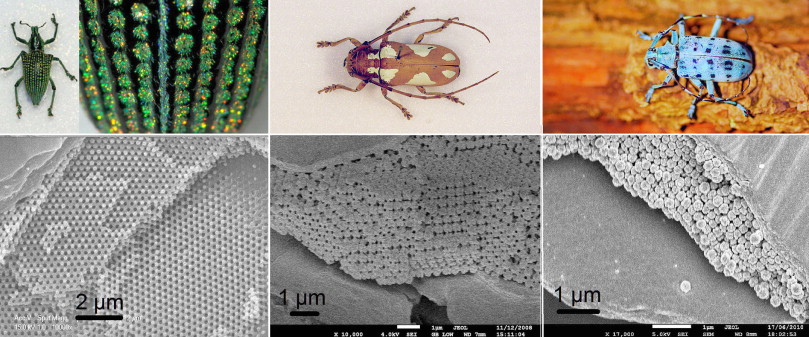Crystals are periodic structures in space. They are used in the electronics industry to control and manipulate electrons. These structures create energy gaps by allowing only electrons with certain energies to propagate, and preventing the propagation of other energies. Can similar energy gaps be designed for the light propagation in a medium? For a long time, such structures were only discussed in theory. However, with the ability to fabricate sub-micron structures, we can control light propagation in a medium in a whole new way. Materials that create energy gaps for light propagation are referred to as a photonic crystal.
It turns out, photonic crystals are not new to nature. For example, they have been observed in the bright colored coats of insects such as longhorns. Various species are able to show different colors by varying the periodicity of the crystals, as shown in the figure below. Similarly, a chameleon can switch its skin color by changing the periodicity of the photonic crystals on its skin.

Three examples of three-dimensional natural photonic crystals: (left) the weevil; (center) & (right) the longhorns. Courtesy of ScienceDirect
Photonic Crystals
Photonic crystals are designed in 1D, 2D are 3D structures as periodic arrangements of dielectric materials. 1D structures consist of alternating layers of dielectrics. In the past, they have been used to design reflectors for optical cavities. 3D structures are used for controlling the cavity modes to enhance or suppress spontaneous emission. This is done by controlling the cavity modes that a material can emit light into. In this article, the use of 2D photonic crystals is stressed. This is because of their unconventional ability to guide light in small cores and sense gases, liquids or biomolecules.

Photonic crystals with various dimensions of periodicity. Image courtesy of Photonic-Lattice
Crystal Fibers
2D photonic crystal (PhC) fibers consist of a core region and a surrounding cladding region, similar to conventional optical fibers. However, rather than having the cladding be uniform, the region is a periodic layer. PhC fibers come in two types: solid core, and hollow core fibers. Each of them can in turn come in hexagonal, triangular, or other geometries. The following is an image of a hollow photonic crystal fiber in hexagonal geometry.

Transverse cross section of a photonic crystal fiber. This specific fiber has a hexagonal periodic inner-structure. The variables refer to the various diameters referred to in the article. The above fiber is used for gas sensing. Image courtesy of OSA Publishing.
The mechanism of guiding in PhC fibers is rather different from conventional fibers. Instead of total internal reflection, the fibers guide light by letting the guided wavelength be in the energy gap of the surrounding photonic crystal. This can also be explained by constructive interference of the various scattering amplitudes. Light propagating in the fiber is scattered from each periodic entity in the surrounding PhC layer. Light propagates when this interference is constructive. If the waves interfere destructively, we say that there is an energy gap at that wavelength, and the light is not guided.
Photonic Crystal Fibers for Gas Sensing
In a work published by M. Morsed et al, a group of scientists from Mawlana Bhashani Science and Technology University in Bangladesh, demonstrated the use of photonic crystal fibers for gas sensing applications. They used a hollow core fiber to accommodate the analyzed substance. The article described a hexagonal PhC fiber just as we described earlier in this post. As it turns out, many gases have their absorption lines in the near infrared region of 0.8 um to 1.8 um. Such gases include methane and hydrogen halides. Methane, for example, has its absorption line at 1.33 um wavelength.
In their experiment, the PhC layer was designed by a periodic arrangement of air holes, with the operation tuned to the near-infrared region (NIR). They let gas enter into the surrounding holes in the fiber, and absorb the evanescent light from the core fiber. Depending on the strength of the absorption line, the output power was reduced strongly at the wavelength of interest. This change was then measured at the fiber output. In this way, various gases with their absorption lines in the NIR region could be sensed, by measuring the change in the output power at the corresponding wavelengths.
Other Applications
PhC fibers can also be used for sensing fluids and biomolecules, just as the gas sensing method we reviewed above. In all cases, the substance being sensed can still be let in through the holes in the PhC layer. The analyzed substance then absorbs the guided light from the core by evanescent waves. However, the materials and the periodic layer need to be re-configured for different sensing applications. A recent review of the various applications of PhC fibers for sensing applications details the the variety of uses of these materials. Applications range from spectroscopy, to bio-medicine, to metrology.
Interested in using photonics for sensing applications? Check out FindLight’s collection of products for gas sensors.
